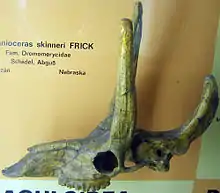Palaeomerycidae
The Palaeomerycidae are an extinct family of ruminants in the order Artiodactyla, probably ancestral to deer and musk deer. Palaeomerycids lived in North America, Europe, Africa, Asia, and South America[1] from 33 to 4.9 million years ago (from the Late Eocene to Pliocene epochs), existing for about 28 million years.[2]
| Palaeomerycidae | |
|---|---|
 | |
| Cranioceras skinneri skull at the Museum für Naturkunde, Berlin | |
| Scientific classification | |
| Kingdom: | Animalia |
| Phylum: | Chordata |
| Class: | Mammalia |
| Order: | Artiodactyla |
| Infraorder: | Pecora |
| Family: | †Palaeomerycidae Lydekker, 1883 |
| Subfamilies | |
| |
Specimens of Amphitragulus, the earliest known genus, have been found in Aragon (Spain), Ronheim (Germany), Sardinia (Italy), France, and Kazakhstan and range from 33 to 15.97 million years old.[3] Fossils of Lagomeryx and Palaeomeryx feignouxi were recovered in Germany and Slovakia from the Middle Eocene.
The oldest known North American specimen, Barbouromeryx, was discovered in Scotts Bluff, Nebraska, and estimated at 23.03 million years old.[4] Palaeomerycids such as Cranioceras and other Dromomerycinae continued to live in North America until the early Pliocene.
Description

Palaeomerycids were a group of horned, long-legged and massive ruminants that could attain a weight of 350 to 500 kg (770 to 1,100 lb).
One of the first known members of this group, Palaeomeryx, was thought to be a hornless form distantly related to the Giraffidae before paleontologist Miguel Crusafont found remains of Triceromeryx in middle Miocene Spain. This Palaeomeryx-like form carried two ossicones over its orbits that were straight and short, similar to those of true giraffids. However, the most striking feature of Triceromeryx was the third, Y-shaped appendage that prolonged the occipital bone at the back of the skull. Discoveries during the 1980s and 1990s showed a surprising variety in these occipital appendages.
Ampelomeryx, a genus of palaeomerycids found at the early Miocene site of Els Casots, Valles-Penedes Basin, Spain, had a three-horned system of appendages similar to those of Triceromeryx. These appendages were, however, quite different, with the paired appendages extending laterally over the orbits, flat and wide, forming an eye-shade, while the third spectacular posterior appendage was about 20 cm (7.9 in) long.
Another species of Triceromeryx, T. conquensis found in La Retama in Spain, showed an even more spectacular appendage — instead of a Y-shaped structure, its posterior appendage was T-shaped with the lateral branches expanding toward the front.
In primitive members of the group (e.g. Ampelomeryx), this appendage was a posterior expansion of the occipital bone lying close to the powerful muscles supporting the skull in a normal position, thus suggesting that this appendage was actually used for fighting between males during the breeding season. The reduced shapes of the flat and laterally oriented appendages of later species suggests that these were not used in active fighting, instead forming a function of passive display.
The limbs were more similar to those of modern large bovids (e.g. buffaloes) than to those of okapis. They probably lived in boggy forests, living on soft leaves and aquatic plants (as hinted to by the brachydont teeth, which are similar to those of primitive giraffids). Their diets consisted of coarse plant material.[5]
As a group, the palaeomerycids appear to have formed a successful part of an independent radiation of horned ruminants that diversified into a variety of forms during the early to middle Miocene, with a geographic range reaching from Spain to China. The giraffids seem to have originated in Asia south of the Alpine belt, while the cervoids seem to have originated north of the Alpine belt.
Taxonomy

The Palaeomerycidae were named by Lydekker (1883). The type genus is Palaeomeryx. The family was assigned to the Artiodactyla by Hulbert and Whitmore (2006), and to Cervoidea by Carroll (1988), Sach and Heizmann (2001) and Prothero and Liter (2007).[7][8]
Classification
- Amphitragulus
- Dromomerycinae
- Asiagenes
- Aletomerycini
- Sinclairomeryx
- Aletomeryx
- Surameryx
- Diabolocornis[9]
- Dromomerycini
- Drepanomeryx
- Rakomeryx
- Dromomeryx
- Subdromomeryx
- Cranioceratini
- Barbouromeryx
- Bouromeryx
- Procranioceras
- Cranioceras
- Pediomeryx
- Yumaceras

- Palaeomerycinae
Genus Lagomeryx (together with its proposed subfamily Lagomerycinae) may be a further member of this family, as well as Ligeromeryx and Stephanocemas (formerly classified as members of Cervidae).
References
- Donald R. Prothero; Kenneth E. Campbell, Jr; Brian L. Beatty; Carl D. Frailey (2014). "New late Miocene dromomerycine artiodactyl from the Amazon Basin: implications for interchange dynamics". Journal of Paleontology. 88 (3): 434–443. doi:10.1666/13-022. S2CID 55245294.
- PaleoBiology Database: Palaeomerycidae, basic info
- S. G. Lucas, E. G. Kordikova, and R. J. Emry. 1998. Oligocene stratigraphy, sequence stratigraphy, and mammalian biochronology north of the Aral Sea, Western Kazakhstan. Bulletin of the Carnegie Museum of Natural History 34:313-348
- B. E. Bailey. 2004. Biostratigraphy and biochronology of early Arikareean through late Hemingfordian small mammal faunas from the Nebraska Panhandle and adjacent areas. Paludicola 4(3):81-113
- Semprebon, Gina; Janis, Christine; Solounias, Nikos (11 July 2004). "The Diets of the Dromomerycidae (Mammalia: Artiodactyla) and Their Response to Miocene Vegetational Change". 24. Taylor & Francis, Ltd. 2: 427–444. Retrieved 14 November 2020.
- Jordi Agustí (2005). Mammoths, sabertooths, and hominids: 65 million years of mammalian evolution in Europe. Columbia University Press. pp. 116–8. ISBN 0-231-11641-1.
- R. C. Hulbert and F. C. Whitmore. 2006. Late Miocene mammals from the Mauvilla Local Fauna, Alabama. Bulletin of the Florida Museum of Natural History 46(1):1-28
- V. J. Sach and E. P. J. Heizmann. 2001. Stratigraphy and mammal faunas of the Brackwassermolasse in the surroundings of Ulm (Southwest Germany). Stuttgarter Beiträge zur Naturkunde Serie B (Geologie und Paläontologie) 310:1-95
- Beatty, Brian Lee (March 2010). "A NEW ALETOMERYCINE (ARTIODACTYLA, PALAEOMERYCIDAE) FROM THE EARLY MIOCENE OF FLORIDA". Journal of Vertebrate Paleontology. Taylor & Francis, Ltd. 30 (2): 613–617. Retrieved 14 November 2020.
External links
 Media related to Palaeomerycidae at Wikimedia Commons
Media related to Palaeomerycidae at Wikimedia Commons